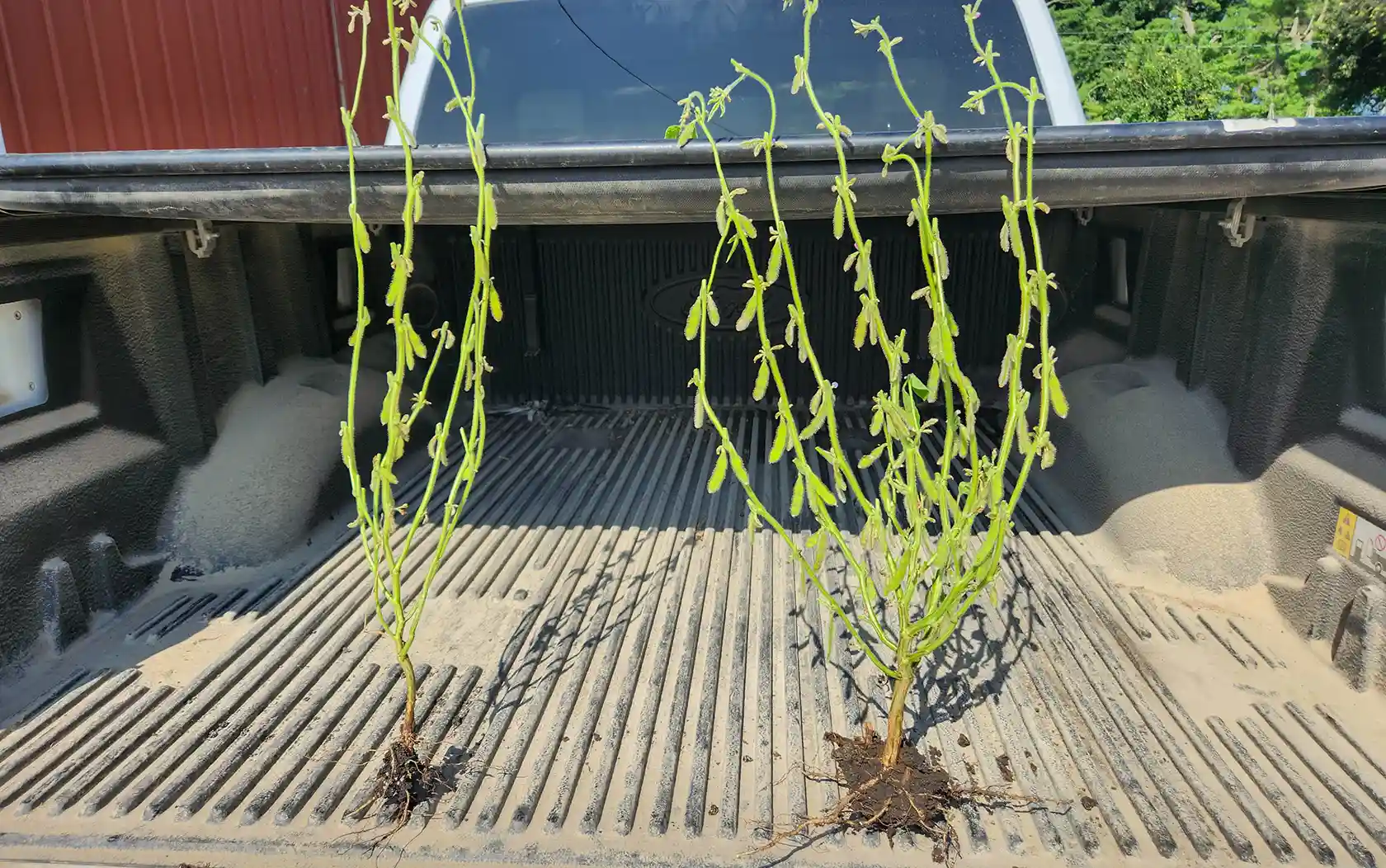
Soybean management trial compares 30-inch rows at 110,000 seeds per acre (right) to 20-inch rows at 140,000 seeds per acre (left). A quick pod count showed about 110 pods on the right and 35 on the left. (Photo: ISA/Alex Schaffer)
Walking Rows 2025: ISA research agronomist update – July 31
July 31, 2025 | Kriss Nelson
With the continuation of warm, wet weather, disease continues to be a concern. Iowa Soybean Association (ISA) research agronomists continue to scout fields in their districts, reporting disease and insect pressure.
Farmers should remain diligent in their scouting, checking for efficacy of their insecticide and fungicide applications.
Alex Schaffer - Central/South Central Iowa
Across central and southern Iowa, soybeans are reaching R4 (full pod) and corn is reaching the R3 stage (milk) growth stages. A large crop is anticipated, based on my observation of many 18-row corn ears and ample moisture to start filling soybean pods.
All modes of fungicide application have been going on with corn mostly finished and some soybean acres still to treat.
I have seen little disease development, but I have noticed quite a bit of insect feeding in soybean fields I have walked. I am eagerly anticipating the results of our fungicide and insecticide trial, where we will be evaluating yield, pathogen and insect pressure with and without fungicide and insecticide alone, as well as the two products together.
 The other trial I am closely watching is a soybean management trial looking primarily at row spacing and population and maximizing return on investment by reducing seeding rate but through a precision planter. The trial is looking into the difference in the 30-inch soybeans planted at 110,000 seeds per acre versus the 20-inch beans planted at 140,000 seeds per acre. I did a quick pod count, and the plant in the 110,000 seeds per acre trial in 30-inch rows had about 35 pods and the plant from the 140,000 seeds per acre at 20-inch soybeans had about 110.
The other trial I am closely watching is a soybean management trial looking primarily at row spacing and population and maximizing return on investment by reducing seeding rate but through a precision planter. The trial is looking into the difference in the 30-inch soybeans planted at 110,000 seeds per acre versus the 20-inch beans planted at 140,000 seeds per acre. I did a quick pod count, and the plant in the 110,000 seeds per acre trial in 30-inch rows had about 35 pods and the plant from the 140,000 seeds per acre at 20-inch soybeans had about 110.
The canopy in the 30-inch beans is about 3 or 4 inches away from totally closing, but weed control is still good. This farmer uses a pre- and a post-emergence herbicide pass with a burndown and residual herbicide in both. The key here is overlapping residual modes of action and timely application of the post-emergence herbicide. If this farmer makes the switch to fully planting his beans with a 30-inch planter, he will reduce his logistics complications with multiple pieces of equipment, create the opportunity for liquid fertilizer and strip-till, and gain the confidence to reduce his seeding rate because of the more accurate placement of the 30-inch planter compared to his 20-inch drill.
Shane Beck – Northeast/Northern Iowa
The rain continues to fall across the state with strong storms early Monday and Tuesday morning. This has led to excess water in fields and some corn being blown over. The excess water has led to ponding and especially in soybean fields, there are areas where we see yellowing, especially in the low areas. The soybeans are starting to die due to the lack of oxygen in the soil. These can be areas that it may be beneficial to address in the future, such as adding more tile or fixing a broken tile if this is a new problem.
Fungicides continue to be applied across the countryside. There are a lot of planes, drones and helicopters applying fungicides and insecticides. High moisture levels caused a significant slowdown of the ground rigs.
 Soybean fields have been very clean from an insect and disease pressure standpoint. I have noticed some damage from Japanese beetles and grasshoppers.
Soybean fields have been very clean from an insect and disease pressure standpoint. I have noticed some damage from Japanese beetles and grasshoppers.
There is a little septoria brown spot present in fields, but I have had to search to find it. Overall, the soybeans that are not standing in water are looking pretty good so far.
I have seen gray leaf spot, northern corn leaf blight, tar spot and rust in the cornfields I have been in, along with corn rootworm beetles. Monitor corn rootworm beetles, especially if you intend to grow corn in the field next year. Managing the adult population can help reduce next year's population in your field.
The fungicide and insecticide should help keep those diseases and insects at bay. Most of these fungicides should provide protection for two to three weeks. It will be important to scout especially for tar spot toward the two- to three-week mark from fungicide application. If tar spot moves in, it might warrant a second application of fungicide.
While scouting a trial in a field near Gowrie, I noticed some feeding patterns I had never seen before on the outside four rows of a soybean field. I found an insect feeding only on the leaf edges. I snapped a few photos and sent them to Ashley Dean, Iowa State University Extension specialist for field crop entomology. She let me know it is an imported longhorned weevil. They are not economically significant pests, so there really is no need to treat for them, but they have a unique feeding pattern and rarely venture very far into the field.
Mikaela Connelly - Southwest/West Central Iowa
The recent rains and warm weather have continued to push the crops along. Soybeans are around R2 to R4 stage and corn at the R4 (dough) stage. The excess rainfall will help with the grain fill process in corn and seed development in soybeans. I’ve seen quite a few fungicide applications happening, specifically in corn, and I’m sure more will continue. The diseases I’ve heard of most this season so far are tar spot, northern corn leaf blight and southern rust, so continue to be on the lookout for these diseases and others. I’ve seen some bacterial blight and minimal frogeye in soybeans, but bacterial blight is not affected by fungicides.

I would say a disease that could pop up the next couple of weeks would be Sudden Death Syndrome (SDS). Disease pressure will be different for each field, so continue to scout your fields for disease. Given the humidity, temperature and excess moisture, the disease triangle has the potential to line up perfectly this year because we have had a favorable environment and pathogens are present.
Craig Woods – Northwest Iowa
Like most of this season, the weather continues to be the largest hurdle this year. Soybeans range from R2-R4 growth stage and corn is around the R1-R3 stages.
Fungicides and insecticides are being applied when the weather cooperates, which is making things difficult to get things done in a timely manner. Ponding is still an issue for areas with poor drainage, thanks to consistent rain that has pulled northwest Iowa off the U.S. Drought Monitor.
Insect pressure has been light in the areas I have scouted, seeing only minimal Japanese beetles, grasshoppers and bean leaf beetles.
 While bean leaf beetles can carry bean pod mottle virus, transmission of the virus is typically most damaging during the vegetative stages as it can still affect yield at this stage.
While bean leaf beetles can carry bean pod mottle virus, transmission of the virus is typically most damaging during the vegetative stages as it can still affect yield at this stage.
Fungal and disease pressure are still light in areas that I have scouted, but I have had reports of southern corn rust across the region and tar spot in the western portions of the district. Scouting is still the best way to monitor the severity of pests and diseases and determine the urgency of possible foliar applications. While scouting, be sure to keep an eye out for white mold and frogeye leaf spot, especially with this continued wet weather.
Lucas De Bruin - Southeast/Eastern Iowa
Fields are still looking good. We have had lots of rain. Rivers are full. The wet spots are definitely starting to show in the bean fields.
Farmers have put on lots of fungicide, and some are applying it to their soybeans aerially because ground rigs cannot get across the fields due to the moisture.
 Hot and wet weather is an excellent recipe for disease in fields. Even if fungicide has been sprayed, it is important to still scout fields and watch for anything new. Soybeans are getting tall in some areas. This is a little concerning with the amount of rain we keep getting. Tall, good looking beans can become short, low yielding beans very quickly with one storm laying them over.
Hot and wet weather is an excellent recipe for disease in fields. Even if fungicide has been sprayed, it is important to still scout fields and watch for anything new. Soybeans are getting tall in some areas. This is a little concerning with the amount of rain we keep getting. Tall, good looking beans can become short, low yielding beans very quickly with one storm laying them over.
Gathered by Kriss Nelson.
Back